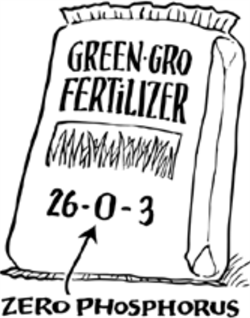The Manufactured Fertilizer Ordinance
In January of 2007, the City passed an ordinance to limit the use of phosphorous in manufactured lawn fertilizers. This ordinance was passed to help protect, restore, and preserve water bodies in and around Ann Arbor, as well as to meet federal and state regulations regarding water quality. By limiting the unnecessary application of phosphorus to lawns, the city can reduce the amount of phosphorus entering the Huron River by 22 percent!

What is Manufactured Fertilizer?
Manufactured fertilizer is any commercially manufactured substance containing plant nutrients that is designed for promoting plant growth, but does not include un-manipulated animal and vegetable manures, marl, lime, limestone, and wood ashes. Many manufactured fertilizers contain phosphorous or compounds containing phosphorous, such as phosphate.
What is Phosphorous?
Phosphorous is a necessary nutrient for root growth in most plant species; however, research from the Michigan State University Extension Service has shown that most mature topsoil in the city has a sufficient level of phosphorus - phosphorous added through the use of manufactured fertilizers therefore is unused by plants and may run off into the Huron River and other water bodies.
Why is Phosphorous Bad for our Water?
During normal watering or rainstorms, unnecessary phosphorus applied to lawns is washed into street stormdrains, which empty directly into local creeks and the Huron River – no filters, no treatment process. Once in the River, the extra phosphorus promotes the rapid growth of algae, which in turn crowds out beneficial water plants. As the algae dies off, the decaying process depletes the water of oxygen, harming fish and insects. If the problem becomes severe enough, lakes downstream can become clogged with algae and scum, and fish kills can result.
The Huron River is the source of up to 90% of the City of Ann Arbor’s water supply. When you help protect the Huron River, you also help protect the water you use every day for drinking, cooking, bathing, laundry, gardening, and other household activities.

Can I Use Fertilizer that Contains Phosphorous?
The ordinance prohibits application of lawn fertilizers containing phosphorous, unless:
- A soil test taken within the last three years indicates that phosphorus is needed. The soil test must demonstrate the level of phosphorus to be less than or equal to 10 parts per million, in which case phosphorus may be applied in the amount and ratio specified by the soil test.
- Lawns are newly seeded or sodded. New lawns can be fertilized with a phosphorus-containing fertilizer for the first growing season or the first four mowings only.
The ordinance applies only to the use of manufactured fertilizers containing phosphorous on lawns; therefore, fertilizers containing phosphorous may be used on garden beds and trees.
Please keep in mind that fertilizer of any type may not be applied:
- On any impervious surfaces (sidewalks, drives, etc.). If fertilizer does spill onto impervious surfaces, you must sweep it up within one hour of the application period.
- Within 25 feet of any wetland, watercourse, stormwater retention, or detention basin.
- Within any natural features open space as defined in Chapter 55 of the City Code
- Prior to April 1st or after November 15th in any calendar year.
How Can I Avoid Using Phosphorous?
Phosphorus-free fertilizer is effective and readily available from major lawn care product manufacturers and distributors. When purchasing fertilizer, check the label on the bag, where you will see a series of three numbers. The first number indicates nitrogen, which is used to promote top growth. The middle number indicates phosphorus, which is used for root growth. The last number indicates potassium, for strong stems and disease resistance. To comply with the ordinance, the middle number in the series of three numbers on the fertilizer bag must read “0,” which means there is no phosphorus in the product. In general, check the turf grass fertilizers for zero phosphorus and avoid “lawn and garden” fertilizers, which are very high in phosphorus.
Please note that the ordinance also requires that all commercial applicators of manufactured fertilizer must register with the City each calendar year. If you use a lawn care company, please ensure that they are registered with the City before they apply any fertilizer to your yard.

Applicator Registration
The ordinance requires that all commercial and institutional applicators of manufactured fertilizer must register with the City each calendar year before applying manufactured fertilizer to any general (non-agricultural) turf in the city. Registration will begin on January 1st and expire on December 31st of each calendar year.
A commercial applicator includes any person who applies manufactured fertilizer in exchange for money, goods, services, or other valuable consideration. An institutional applicator includes any person who applies manufactured fertilizer to general turf areas of more than 1 acre, excluding owners of individual parcels zoned single-family.
To register online, please click
here. Or, submit this form to the City Clerk's office.
What is the Penalty for Applying Phosphorous Fertilizers?
Each violation of the ordinance will be a civil infraction, punishable by a fine of up to $1,000, and not less than $250. The minimum fine is $500 for commercial and institutional applicators.
Learn More
For more information, please read the
Manufactured Fertilizer Ordinance, contained in Chapter 70 of the City Code.
Additionally, to report a violation of the ordinance or for further information, please contact the Fertilizer Program Administrator, Sean Reynolds, at [email protected] or 734.794.6000 x43737.
